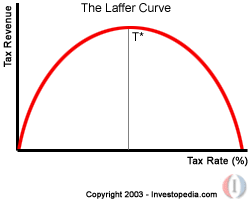The logic underlying the Laffer Curve is that the greater the tax on production, the lesser the amount of production. As a broad-brushed economics principle this is reasonable, but the Laffer Curve itself is bogus. Unfortunately, this bogus curve is being used to justify bad government policy.
Before I get into why it is bogus and how it is being used to justify bad policy, here is a representation of the Laffer Curve from an Investopedia article:

And here is how the Laffer Curve is described in the above-linked article:
“The Laffer Curve suggests that, as taxes increase from low levels, tax revenue collected by the government also increases. It also shows that tax rates increasing after a certain point (T*) would cause people not to work as hard or not at all, thereby reducing tax revenue. Eventually, if tax rates reached 100%, shown as the far right on his curve, all people would choose not to work because everything they earned would go to the government. Governments would like to be at point T*, because it is the point at which the government collects maximum amount of tax revenue while people continue to work hard.”
One of the problems with the Laffer Curve is that the relationship between tax rates and tax revenue cannot be expressed as a simple curve. In fact, it can’t be expressed by any curve. This is because tax revenue is affected by a myriad of variables, not just the average tax rate. However, there are much bigger problems.
A second problem is that the Laffer Curve puts the focus on maximising government revenue when the focus of economists should be on maximising living standards. A related problem is that by putting the focus on tax rates the Laffer Curve takes the focus away from what really matters, which is the total amount spent by the government. All else remaining the same, higher government spending combined with a lower average tax rate is worse for the economy than lower government spending combined with a higher average tax rate. The reason is that if the government is running a deficit, then reducing the tax rate and simultaneously increasing government spending will quicken the pace at which private-sector savings are siphoned to the government. This happens because a government deficit can only be funded by private-sector savings.
Another problem is that there is often a big difference between the official tax rate and the effective tax rate. For example, the US corporate tax rate is presently 35%, but the average rate of corporate tax actually paid in the US is only 22%. For the purpose of this discussion let’s assume, however, that a change in the tax rate would initially lead to a proportional change in the amount of tax being paid. That is, let’s assume for the sake of argument that a 5% reduction in the US corporate tax rate would initially lead to an average reduction of 5% in the corporate tax burden. Having made this assumption we get to an additional problem.
The additional problem is that the Laffer Curve implies a potential outcome that is, as far as I can tell, impossible. If the Laffer Curve is right, then the government taking less money from the private sector potentially would result in both the government and the private sector ending up with more money. Unless I am missing something this could only be possible if the money supply were to increase, meaning that at its core the Laffer Curve relies on a form of monetary illusion.
The biggest problem of all, though, is that the Laffer Curve is downright dangerous to the extent that it seemingly removes the need to implement cuts in government spending to fund cuts in taxes. Thanks to the support provided by this bogus curve, unscrupulous and/or ignorant politicians can promote tax-cutting plans that have no offsetting spending cuts based on the idea that lower tax rates will eventually bring about a counter-balancing increase in tax revenue. The potential result is a tax-cutting plan that quickens the pace at which private-sector savings are siphoned to the government, that is, a tax-cutting plan that leads to slower economic progress.
 Print This Post
Print This Post
